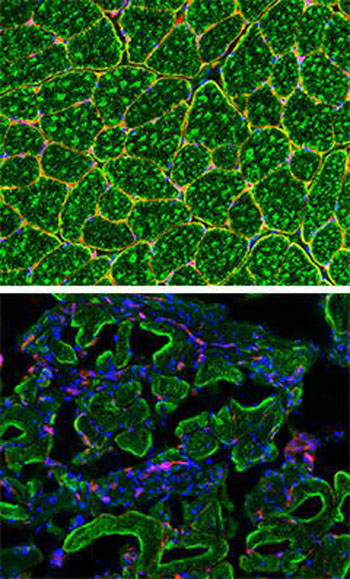Role of Laminin Defined in Muscular Dystrophy-Related Stem Cell Differentiation
By LabMedica International staff writers
Posted on 13 Jun 2016
The structural protein laminin has been found to play a critical role in determining whether a class of stem cells linked to the development of muscular dystrophy (MD) matures into muscle – which could prevent development of MD – or into fat – which would contribute to the development of MD.Posted on 13 Jun 2016
Muscle-resident PDGFRbeta+ cells, which include pericytes and PW1+ interstitial cells (PICs), play a dual role in muscular dystrophy. They can either undergo myogenesis (generation of muscle cells) to promote muscle regeneration or differentiate into adipocytes (fat cells) and other cells to compromise regeneration and drive MD development. However, the factors that regulate the differentiation and fate determination of PDGFRbeta+ cells had not previously been determined. However, previous studies with mouse models had shown that loss of the structural protein laminin contributed to at least some forms of muscular dystrophy.

Image: Blocking expression of laminin (red) in pericyte and PIC stem cells in mice caused dramatic alteration to muscle fiber maturation (green), similar to that seen in muscular dystrophy patients (Photo courtesy of Rockefeller University).
Investigators at the Rockefeller University (New York, NY, USA) worked with a model system based on genetically engineered conditional knockout mice with laminin deficiency in PDGFRbeta+ cells.
The investigators reported in the May 3, 2016, online edition of the journal Nature Communications that treatment with laminin alone was able to partially reverse the muscle dystrophic phenotype in these mice at the molecular, structural, and functional levels. RNAseq analysis revealed that laminin regulated PDGFRbeta+ cell differentiation and fate determination via the protein gpihbp1 (Glycosylphosphatidylinositol anchored high density lipoprotein binding protein 1). This protein is found primarily in capillaries where pericytes reside, and previous research had shown that it was involved in fat metabolism.
Forcing mouse pericytes and PICs that lacked laminin to activate gpihbp1 caused these cells to differentiate preferentially into muscle cells.
"Our data suggests that gpihbp1 could be a novel target for the treatment of muscular dystrophy," said senior author Dr. Sidney Strickland, professor of neurobiology and genetics at the Rockefeller University.
Related Links:
Rockefeller University














